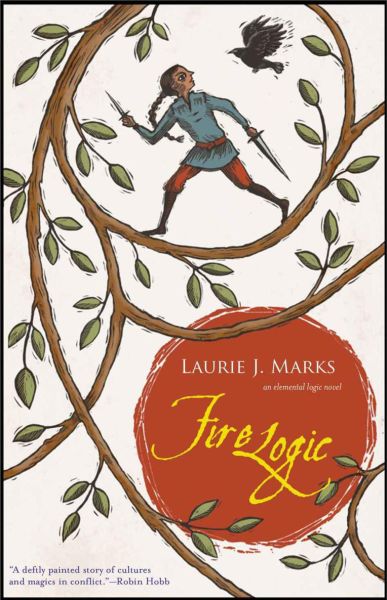Someone whose books I need to obsessively collect.
Fire Logic (Elemental Logic, volume 1)
By Laurie J Marks

4 Nov, 2014
0 comments
I think Fire Logic is my first Marks novel. It is certainly not my last. Normally my Rediscoveries are books familiar to me but not to others. In this case, I am the beneficiary of someone else’s experience.
Fire Logic begins rather like Harris’ Seven Citadels quartet (or The Lantern Bearers, or indeed a lot of secondary world series). For the last generation, Shaftal has suffered a continuing invasion from the Sainnites, an aggressive warrior people of unclear origins. Despite the wise guidance of Harald G’Deon, Shaftal has done nothing effective to drive the invaders back into the sea. Two grim bits of news mark the end of Harald’s era: Harald has died without naming an heir and the Sainnites have taken the holy city of Lilterwess, leaving none alive.
With no acknowledged heir to Harald’s power, the Shaftali are forced to fall back on mundane tactics. Guided by Councilor Mabin’s book, Warfare, Shaftal’s forces, the Paladins, stop meeting the invaders in open battles that the Shaftali can only lose. They start using guerrilla tactics instead. Nobody familiar with conflicts like this will be surprised to learn that this quickly spirals into a cycle of atrocities.
The Sainnites are nothing if not thorough in their quest to collect all the enemies. On the advice of a seer, they lash out at the Ashawala’i, who were until then content to sit out the war in nervous neutrality. As we learn later, the seer foresaw that the Ashawala’i would be her people’s doom; it was only after the massacre that the seer seems to have remembered the concept of “self-fulfilling prophecy.” In the immediate aftermath of the massacre, a handful of surviving Ashawala’i with nothing to lose spend their lives killing as many Sainnite soldiers as they can. This is a loss the Sainnites can ill afford.
If that wasn’t bad enough, the massacre sends the lone surviving Ashawala’i, Zanja, on a painful path towards the doom that haunted the seer’s dream.
For Zanja, that path involves capture, torture, rescue, and a long career as a resistance fighter; for the earth witch Karis who saves Zanja, a long struggle with the chains that bind her. Although Zanja only gains an inkling of this late in her career opposing them, the Sainnites are caught in a terrible bind. They are almost certainly doomed to be assimilated or exterminated by those they have invaded. The question is whether the Shaftali can prevail without losing their souls in the process.
You’d think “self-fulfilling prophecy 101” would be the first course seers take but it always seems to be left off their curricula. In retrospect, I should have seen that coming.
This takes an unfashionable stance against crimes against humanity, rather odd for a work of speculative fiction. It’s not just that being creatively nasty to the other side is bad in a theoretical sense or that it’s hard on the targets of the atrocities; it’s also not great for the people committing the atrocities. The Sainnites, for example, seem to have lost every problem solving skill that isn’t “kill it harder” and while one of their number does manage to cast off his cognitive blinders, it is probably significant that he is of mixed Sainnite/Shaftali origin.
A minor aside: I wonder what the most frequent non-standard pluralization is in fantasy novels? Tacking an “i” on the end must be way up there.
People who don’t care for gruesomely violent books may want to avoid this one, because pretty much everyone in this eventually ends up owner of a tragic back-story and a lot of those stories involve fairly horrific injuries. Zanja in particular seems determined to have Wolverine’s life style without his healing factor; she gets physically battered more than a Tim Powers protagonist. Don’t get me wrong: all the bad stuff is in there for a reason other than to revel in gore and nastiness, but it is there.
This hits an almost perfect balance between functioning as a novel and as an installment in a series. I put the book down satisfied but wanting more. The good news is there is more to be had. The bad news is that Fire Logic came out in 2002, Earth Logic in 2004, and Water Logic in 2007 … but, if you check the author’s site, you will see that the final volume is Air Logic, a work in progress. I am as upset as you are.
